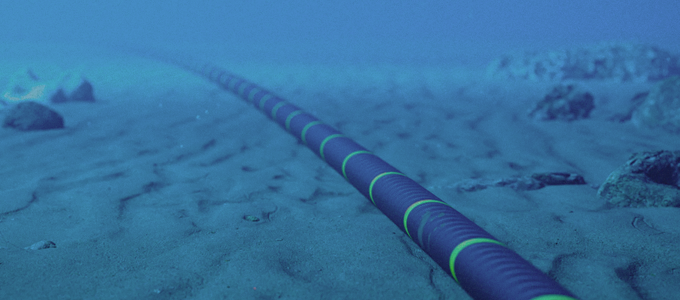Subsea Cables: Overview and Evolution for the Regional Internet
15/11/2023

By Carlos Martínez, LACNIC CTO
The recent LACNIC-LACNOG event included a variety of interesting presentations and talks, one of which brought together a group of experts working with the main submarine cable infrastructure providers in the region.
Organized jointly by LACNIC and Rogério Mariano, Global Head of Edge Strategy at Azion and responsible for moderating the panel which included Lucenildo Lins de Aquino Junior, from Angola Cables; Leonardo Almeida, IP Network Manager at Seaborn Networks; Fabio Montero of Telecom Italia Sparkle; Rafael Lozano of EllaLink; Fabio Laguado, Head of Sales and Country Manager US at VTal Data Centers; and Esther Fernández, director of interconnection strategy at Telxius.
Panelists observed that due to its geographic location, the venue chosen for the event, the Brazilian city of Fortaleza, holds a strategic position as the hub for several of the world’s most important submarine cables, directly connecting Latin America with Africa and Europe through Brazil. One of the features of the city that is particularly important for any cable anchoring location is that the sea deepens rapidly from the coastline, thus minimizing the risk of common damages, such as those caused by boats anchoring or fishing activities. Another important aspect to keep in mind is that cable infrastructure is a very tempting target for sabotage.
In the event of any such accident, the consequence for the user is a loss of service or slower operation until the cable is repaired, traffic is routed through other cables or through the terrestrial network, depending on the severity of the incident. In this sense, it’s worth mentioning that during the peak of the first generation of cables back in the 2000s, the terrestrial fiber network was limited, which led to a significant reliance on submarine cables. Today, the terrestrial fiber network has expanded significantly and supports subsea cables, which clearly shows the evolution of regional infrastructure.
Cables can also be affected by natural events. The account shared by Angola Cables regarding how they addressed a natural phenomenon affecting the cables on the coast of Africa was very interesting. Because of the weights attached to the cables to maintain them on the seabed, a portion of the cable in question was laid through a lengthy and narrow canyon. This canyon follows the mouth of the fast-flowing Congo River, which carries large amounts of mud and sediments, which are dumped onto the seabed and can damage the cable. The solution they found was to add a buoy to keep the part of the cable that crosses that section from falling to the seabed and being affected by the mud.
From a technical point of view and against popular belief, subsea fiber optic cables have a thickness of not more than 5 or 6 centimeters; what does make a difference is the number of fiber pairs they carry. In this sense, it is worth stressing that the transmission capacity of the fiber pair can be multiplied several times. When it comes to having a smaller number of intermediate sites to reach long distances and achieve higher capacities, the most effective solution is Dense Wavelength Division Multiplexing (DWDM) technology. DWDM is a transmission technique that involves multiplexing many different wavelength signals onto a single fiber, in other words, it segments light into various wavelengths (i.e., colors) to transmit them over a single optical fiber. For practical purposes, each color behaves as if it were a different fiber.
In fact, in the last two or three decades, this technology has made it possible to increase the installation of cables, as it allows building smaller cables that can be transported and installed more easily and, consequently, lowering their cost. Indeed, this process can be performed on cables that are already installed and thus extend their lifespan. This is much cheaper than installing the technology from scratch.
Other technologies for lowering costs and improving transmission are applied to signal regenerating equipment, which are installed in the water every certain number of kilometers for the purpose of receiving a signal, converting it to an electrical signal once again, and regenerating it as an optical signal. The panel pointed out that in the past, a signal regenerator was required every 200 km. However, with current technologies, a cable spanning from Fortaleza to Miami now needs no more than two or three signal regenerators whereas, a mere couple of years ago, ten or twelve would have been required. This represents another major step forward in terms of installation costs and the prevention of failures.
From the business perspective, the submarine cable industry is unique in its demand for long-term investments. Considering that cables have an approximate lifespan of 20 years, the outlook of legal certainty and economic stability is vital.
Likewise, all submarine cable infrastructure providers participating in the panel shared how they have diversified their business towards other services, primarily datacenters.Initially, many of these providers connected their cables to third-party datacenters, mainly telecommunications companies. However, they eventually shifted towards establishing their own datacenters, from where they can offer other types of added services to companies that need to establish a local presence. The other significant development is the appearance of OTT service providers as owners of entire cables or as shareholders in cable consortiums. A decade ago, those laying submarine cables were telecommunications companies, and other companies were their clients. What does the situation look like today? Content providers continue to be a major influence on broadband traffic in Latin America. The volume of traffic handled by companies like Google and Facebook has reached a point where it makes more sense for them to invest in their own cables to improve the availability of their services.